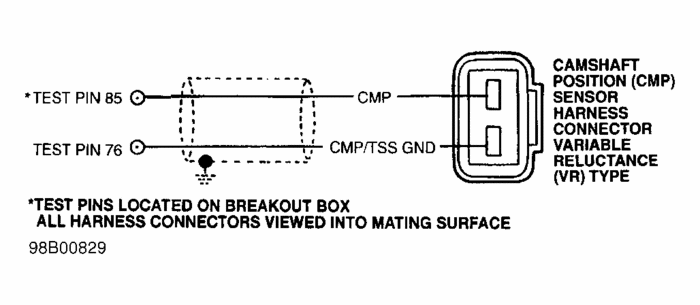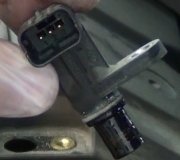1) DTC P0340
This DTC indicates PCM has detected a CMP sensor circuit fault. Possible causes for this fault are:
CMP circuit open or shorted wiring harness.
PWR GND or VPWR circuit open (Hall Effect type CMP sensor).
SIG RTN circuit open (Variable Reluctance type CMP sensor).
Faulty CMP sensor.
Faulty PCM.
Attempt to start engine. If engine starts, go to next step. If engine does not start, go to CIRCUIT TEST A.
2) Attempt To Generate DTC P0340
Clear PCM memory. Start engine. Raise engine speed to 1500 RPM for 10 seconds. Return to idle speed. Raise engine speed to 1500 RPM for 10 seconds again. Turn ignition off. Perform QUICK TEST to retrieve Continuous Memory DTCs. If DTC P0340 is not present, fault is intermittent. Go to CIRCUIT TEST Z. If DTC P0340 is present, go to next step (Hall Effect type CMP sensor) or step 5) (Variable Reluctance type CMP sensor).
3) Check VPWR Circuit Voltage
Turn ignition off. Disconnect CMP sensor connector. Turn ignition on. Measure voltage between VPWR terminal at CMP sensor wiring harness connector and negative battery terminal. If voltage is more than 10.5 volts, go to next step. If voltage is 10.5 volts or less, repair open in VREF circuit.
4) Check PWR GND To CMP Sensor
Turn ignition off. Measure resistance between PWR GND circuit at CMP sensor wiring harness connector and negative battery terminal. If resistance is less than 5 ohms, go to next step. If resistance is 5 ohms or more, repair open in PWR GND circuit.
5) Check For Open Circuit
Disconnect PCM 104-pin connector. Inspect connector for loose, damaged or corroded terminals. Install Breakout Box (014-00950), leaving PCM disconnected. Measure resistance between test pin No. 85 (CID) at breakout box and CMP terminal at CMP sensor wiring harness connector. Also measure resistance between test pin No. 76 and CMP/TSS GND terminal at CMP sensor wiring harness connector. If both resistance readings are less than 5 ohms, go to next step. If any resistance reading is 5 ohms or more, repair open circuit.
6) Check CMP Circuit For Short To Power
Ensure CMP sensor is disconnected. Turn ignition on. Measure voltage between test pin No. 85 and test pins No. 51 and 103 (PWR GND) at breakout box. If voltage is less one volt, go to next step. If voltage is one volt or more, repair CMP circuit short to power.
7) Check CMP Circuit For Short To Ground
Turn ignition off. Disconnect scan tool Data Link Connector (DLC). Measure resistance between test pin No. 85 and test pins No. 51, 103 (PWR GND) and 91 (SIG RTN) at breakout box. If all resistance readings are more than 10,000 ohms, go to next step. If any resistance reading is 10,000 ohms or less, repair short to ground or SIG RTN in CMP circuit.
8) Check For Short In PCM
Connect PCM to breakout box. Measure resistance between test pin No. 85 and test pins No. 23, 51, 71, 91, 97 and 103 at breakout box. If all resistance readings are more than 500 ohms, go to next step (Variable Reluctance type CMP sensor) or step 10) (Hall Effect type CMP sensor). If any resistance reading is 500 ohms or less, replace PCM.
9) Check CMP Sensor Output
Turn ignition off. Reconnect CMP sensor connector. Set DVOM on AC scale to monitor less than 5 volts. Start engine. Measure voltage between test pins No. 85 and 51 while varying engine speed. If voltage varies more than one volt, replace PCM. If voltage does not vary more than one volt, replace CMP sensor.
10) Check CMP Sensor Voltage Output
Turn ignition off. Disconnect PCM connector. Ensure CMP sensor is installed properly. Connect DVOM between test pins No. 85 and 51. Using starter, bump engine (do not allow engine to start) for at least 10 engine revolutions. If voltage switches from less than 2 volts to more than 8 volts, replace PCM. If voltage does not switch from less than 2 volts to more than 8 volts, replace CMP sensor.
Image (Click to make bigger)
SPONSORED LINKS
Thursday, January 27th, 2011 AT 7:45 AM




